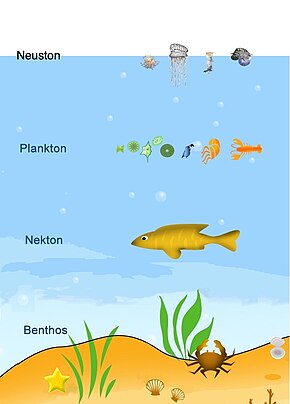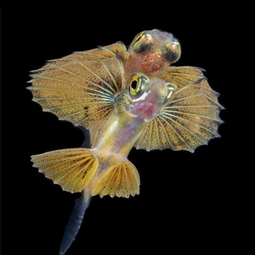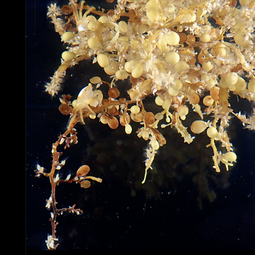Neuston
Neuston, also called pleuston, are organisms that live at the surface of a body of water, such as an ocean, estuary, lake, river, or pond. Neuston can live on top of the water surface or may be attached to the underside of the water surface. They may also exist in the surface microlayer that forms between the top side and the underside. Neuston have been defined as "organisms living at the air/water interface of freshwater, estuarine, and marine habitats or referring to the biota on or directly below the water’s surface layer."[1]
The word neuston comes from the Greek neustos, meaning "swimming" + -on (as in "plankton").[2] This term first appears in the biological literature in 1917.[3] The alternative term pleuston comes from the Greek plein, meaning "to sail or float". The first known use of this word was in 1909, before the first known use of neuston.[4] In the past various authors have attempted distinctions between neuston and pleuston, but these distinctions have not been widely adopted. As of 2021, the two terms are usually used somewhat interchangeably, and neuston is used more often than pleuston.
Overview

emblematic figure of the marine pleuston

The neuston of the surface layer is one of the lesser known aquatic ecological groups.[5] The term was first used in 1917 by Naumann to describe species associated with the surface layer of freshwater habitats.[3] Later in 1971, Zaitsev identified neuston composition in marine waters.[6] These populations would include microscopic species, plus various plant and animal taxa, such as phytoplankton and zooplankton, living in this region.[6][7] In 2002, Gladyshev further characterised the major physical and chemical dynamics of the surface layer influencing the composition and relationships with various neustonic populations"[8][7]
The neustonic community structure is conditioned by sunlight and an array of
Types

There are different ways neuston can be categorised. Kennish divides them by their physical position into two groups:[1]
- epineuston: organisms living on the water’s surface
- hyponeuston: organisms within a region of specified depth directly below the surface layer
To this can be added the organisms living in the microlayer at the interface between air and water:
- microlayer neuston: organisms (microorganisms) living in the surface microlayer sandwiched between the upper and under surface.
Marshall and Burchardt divide neuston into three ecological categories:[7][5]
- euneuston: organisms with maximum abundance in the vicinity of the surface on which they reside day and night
- facultative neuston: organisms concentrating at the surface only during certain hours of the day, usually during darkness
- pseudoneuston: organisms with maximum concentrations at deeper layers but reaching the surface layer at least during certain hours.
Freshwater neuston
Freshwater neuston, organisms living at lake or pond surfaces or slow moving parts of rivers and streams, include
-
-
Water spider
-
Waterstrider Gerris commun
-
Floods
There are different terrestrial environmental factors such as flood pulses and droughts, and these environmental factors affect species such as neuston, whether the effects lead to more or less variations in the species. When flood pulses (an abiotic factor) occur, connectivity between different aquatic environments occur. Species that live in environments with irregular flood patterns tend to have more variations, or even decrease species and variations; similar idea to what happens when droughts occur.[19]
Red fire ants have adapted to contend with both flooding and drought conditions. If the ants sense increased water levels in their nests, they link together and form a ball or raft that floats, with the workers on the outside and the queen inside.[20][21][22] The brood is transported to the highest surface.[23] They are also used as the founding structure of the raft, except for the eggs and smaller larvae. Before submerging, the ants will tip themselves into the water and sever connections with the dry land. In some cases, workers may deliberately remove all males from the raft, resulting in the males drowning.
The longevity of a raft can be as long as 12 days. Ants that are trapped underwater escape by lifting themselves to the surface using bubbles which are collected from submerged substrate.[23] Owing to their greater vulnerability to predators, red imported fire ants are significantly more aggressive when rafting. Workers tend to deliver higher doses of venom, which reduces the threat of other animals attacking. Due to this, and because a higher workforce of ants is available, rafts are potentially dangerous to those that encounter them.[24]
Marine neuston
The marine neuston, organisms living at the ocean surface, are one of the least studied planktonic groups. Neuston occupies a restricted ecological niche and is affected by a wide range of endogenous and exogenous processes while also being a food source to zooplankton and fish migrating from the deep layers and seabirds.[5]
The neustonic animals form a subset of the zooplankton community, which plays a pivotal role in the functioning of marine ecosystems. Zooplankton are partially responsible for the active
-
Portuguese man-o-warPhysalia sp.
-
By-the-wind sailor Velella sp.
-
Blue button Porpita sp.
-
Flying fish from the familyExocoetidae
-
Buoy barnacleDosima fascicularis
-
Blue sea dragons Glaucus sp.
Historically, zooplankton assemblages research has focused mainly on taxonomic studies and those related to community structure.
-
Paper nautilusArgonauta sp.
-
Sargassum sp. seaweed
-
Hippolytidae shrimp
-
Marine snail Recluzia sp.
-
Violet snail Janthina sp.
-
Floating anemone Actinecta sp.
Coral-treaders are a genus of quite rare wingless marine bugs known only from coral reefs in the Indo-Pacific region. During low tide they move over water surfaces around coral atolls and reefs similar to the more familiar water-striders, staying submerged in reef crevices during high tide.
See also
- Bacterioneuston
- Virioneuston
References
- ^ S2CID 129770661.
- ^ Merriam-Webster Dictionary: neuston. Accessed 18 December 2021.
- ^ a b Naumann, E. (1917) "Beiträge zur Kenntnis des Teichnannoplanktons. II. Über das Neuston des Süsswassers", Biologisches Zentralblatt, 37: 98–106.
- ^ Merriam-Webster Dictionary: pleuston. Accessed 18 December 2021.
- ^ hdl:10754/667566..
 Material was copied from this source, which is available under a Creative Commons Attribution 4.0 International License
Material was copied from this source, which is available under a Creative Commons Attribution 4.0 International License - ^ a b Zaitsev, Y. P. (1971) "Marine Neustonology". National Marine Fisheries Service, NOAA and NSF, Washington DC.
- ^ .
- OCLC 49871862.
- S2CID 84508946.
- ^ S2CID 135269465.
- ^ a b Hempel, G. and Weikert, H. (1972) "The neuston of the subtropical and boreal North-eastern Atlantic Ocean. A review". Marine Biology, 13(1): 70–88.
- ^ Cheng, L., Spear, L. and AINLEY, D.G. (2010) "Importance of marine insects (Heteroptera: Gerridae, Halobates spp.) as prey of eastern tropical Pacific seabirds". Marine Ornithology, 38": 91–95.
- ^ Zaitsev, Y. P. (1971). Marine Neustonology. ed. K. A. Vinogradov (Jerulasem: Israel program for scientific translations).
- S2CID 84587026.
- ^ Ebberts, B. D., and Wing, B. L. (1997). "Diversity and abundance of neustonic zooplankton in the North Pacific subarctic frontal zone". U.S. Department of Commerce, NOAA Technical Memorandum NMFS-AFSC-70.
- doi:10.1139/z89-284.
- .
- ^ Padmavati, G. and Goswami, S.C. (1996). "Zooplankton distribution in neuston and water column along west coast of India from Goa to Gujarat". Indian J. Mar. Species, 25: 85–90.
- ^ Conceição, E. de O. da, Higuti, J., Campos, R. de, & Martens, K. (2018). Effects of flood pulses on persistence and variability of pleuston communities in a tropical floodplain lake. Hydrobiologia, 807(1), 175–188.
- PMID 21518911.
- JSTOR 3493830.
- ^ Hölldobler & Wilson 1990, p. 171.
- ^ PMID 22950473.
- S2CID 24420242.
- .
- PMID 26338976.
- S2CID 227191974.
- ^ .
- ^ PMID 26811565.
- ^ S2CID 197594398.
- ^ S2CID 25218654.
- PMID 29545783.
- S2CID 3400176.
- S2CID 16280978.
- ^ .
- .
- .
- .
- PMID 23360597.
- .
- S2CID 216070768.
- S2CID 55732646.
- S2CID 91541174.
- S2CID 90358144.
External links
- "neuston - Britannica Online". Encyclopædia Britannica. Retrieved 2007-11-13.



















